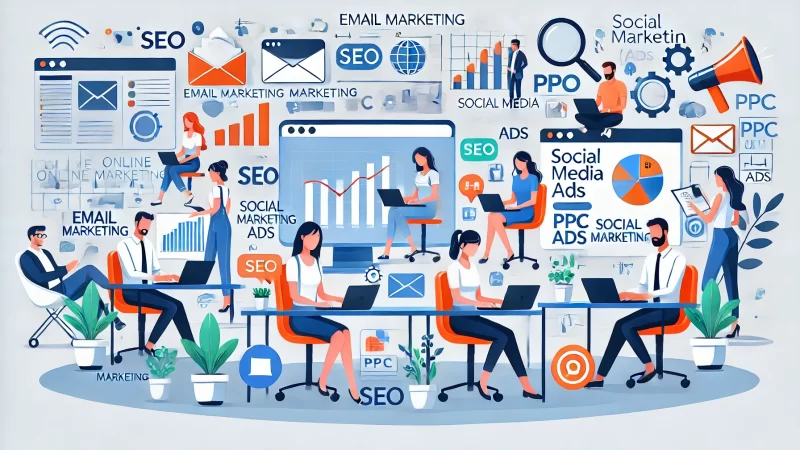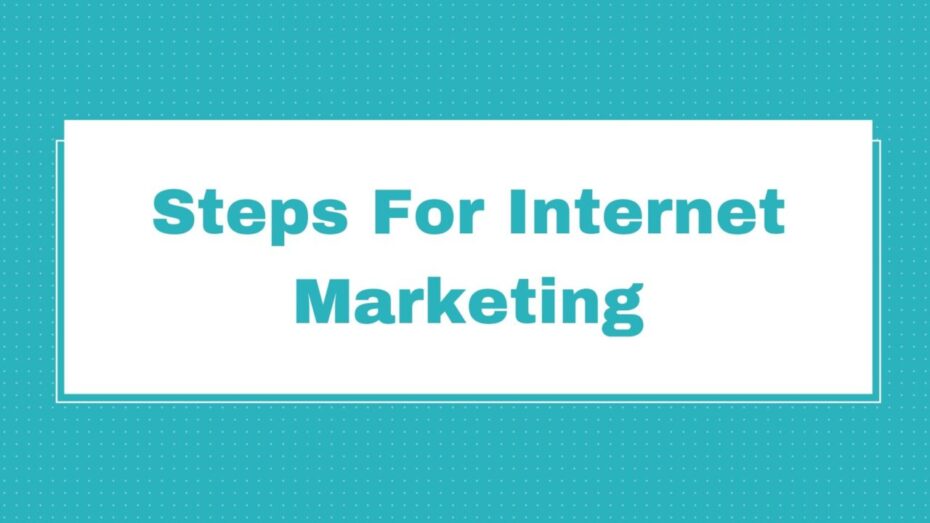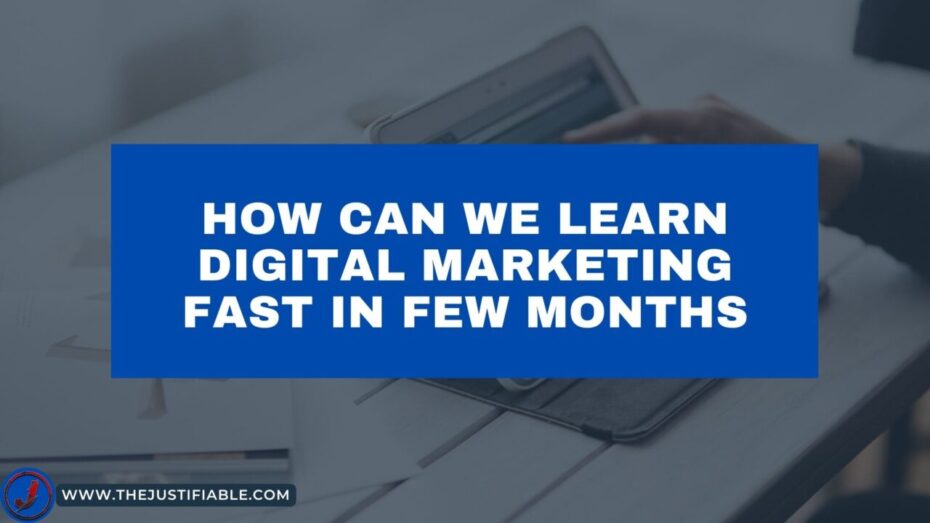Are you wondering how to do online marketing business effectively and profitably? Starting an online marketing business may seem daunting, but with a structured approach, you can build a thriving enterprise.
This guide walks you through ten simple, actionable steps to set up and scale your online marketing business successfully.
Step 1: Define A Niche And Target Audience
Before starting an online marketing business, it’s essential to define your niche and pinpoint your target audience. This foundational step ensures your efforts are focused on the right people, helping you stand out in a crowded market.
Research Profitable Online Marketing Niches
Choosing the right niche is the cornerstone of your success. I recommend focusing on areas where there’s high demand and less saturation. Start by identifying industries that align with your expertise or passion and evaluate their market potential.
You can explore tools like Google Trends and SEMrush to find niches with consistent interest over time. For example, digital marketing for e-commerce businesses has been booming due to the rise of online shopping. Selecting a growing niche can provide long-term profitability.
Look at underserved markets within your chosen niche. Let’s say you’re targeting social media marketing; niches like TikTok strategy or LinkedIn advertising may be less crowded but highly lucrative. Prioritize areas where your skills can solve specific problems.
Always validate your niche choice by conducting surveys or interviews. Ask potential clients about their challenges and whether they’d invest in your services. Feedback is invaluable for narrowing your focus and building an offer that resonates.
Keep your niche specific enough to differentiate yourself but broad enough to scale later. For instance, targeting “SEO for local restaurants” combines specialization with room for growth as you expand to other industries.
Identify Pain Points And Customer Needs
Understanding what your target audience struggles with allows you to offer solutions they truly value. I suggest getting into the mindset of your ideal customer to uncover their biggest challenges.
Start by engaging in forums or groups where your target audience hangs out. Platforms like Reddit and Facebook groups are goldmines for identifying recurring questions or frustrations. Take note of these pain points to shape your marketing messages.
Ask open-ended questions in surveys or during consultations to dig deeper into their needs. For instance, a small business owner might say they’re struggling with “not enough website traffic.” You can then tailor your services to address this directly.
Use customer personas to organize your findings. These profiles should include demographic information, challenges, and goals. Having a clear picture of who you’re serving will keep your messaging consistent and relatable.
When addressing pain points, highlight how your services alleviate these issues. For example, if they struggle with email marketing, explain how you can help them increase open rates and drive sales. Specific, outcome-driven language builds trust.
Understand Competitor Strategies In Your Niche
Knowing what your competitors are doing well—and where they’re falling short—gives you a competitive edge. I suggest starting with a competitor analysis to uncover insights that can shape your approach.
Identify your top competitors using tools like Bigspy or SpyFu. These platforms reveal who ranks for your target keywords and what strategies they’re using. Study their websites, social media, and content to understand their strengths.
Pay attention to gaps in their offerings. If a competitor lacks personalized service or struggles with consistency, make these areas your strengths. Standing out doesn’t require reinventing the wheel—it’s about doing what others aren’t.
Analyze the tone and style of your competitors’ communication. Are they formal, casual, or technical? Matching your style to your audience’s preferences can make a big difference in building rapport and trust.
Leverage reviews of competitors’ services to identify what customers love and what they criticize. Use this feedback to fine-tune your offerings and avoid common pitfalls. For example, if customers complain about poor follow-up, make responsiveness your priority.
Step 2: Develop A Strong Online Marketing Plan

Creating a robust online marketing plan is essential for success. A clear strategy helps you stay focused, prioritize tasks, and measure your progress effectively. Let’s explore how to lay the foundation for a solid plan.
Set Clear And Achievable Business Goals
Defining specific goals is the first step in building a successful online marketing plan. I suggest starting with outcomes that are realistic, measurable, and aligned with your business objectives.
Begin by asking yourself what you want to achieve. Is it to generate more leads, increase sales, or build brand awareness? For example, if you aim to grow website traffic, set a goal like “Increase monthly visitors by 20% within six months.” Such clarity ensures every action you take contributes to a tangible outcome.
Break your goals into smaller, actionable steps. If boosting website traffic is your goal, your plan might include publishing weekly blog posts, optimizing for search engines, and running ad campaigns. This approach makes big goals more manageable and less overwhelming.
Keep track of progress regularly. Use tools like Monsterinsights to monitor website traffic or HubSpot for lead management. Celebrate small wins, as they keep you motivated and on track to achieve bigger milestones.
Don’t forget to revisit and adjust your goals as your business evolves. For example, once you achieve your initial traffic goal, you might shift your focus to improving conversion rates. Flexibility is key to long-term success.
Create A Marketing Calendar For Consistent Growth
A marketing calendar keeps you organized and ensures consistency, which is crucial in the online marketing business. I recommend using a calendar to plan campaigns, content, and other activities in advance.
Start by outlining your monthly and quarterly objectives. For instance, if you’re launching a new service, your calendar might include pre-launch promotions, email campaigns, and social media posts leading up to the release. Having a timeline ensures you’re prepared every step of the way.
Use tools like Trello, Asana, or Google Calendar to structure your plan. Assign tasks to specific dates and team members if you have collaborators. Seeing the big picture laid out visually helps you stay on top of deadlines.
Incorporate various content types into your calendar. Balance blog posts, videos, social media updates, and newsletters to keep your audience engaged. For example, schedule one blog post per week and pair it with supporting social media content.
Review and adjust your calendar as needed. If a particular campaign isn’t performing well, don’t hesitate to shift focus or tweak your approach. The goal is to maintain momentum and maximize your results.
Allocate Budgets For Marketing Tools And Campaigns
Budgeting is a crucial part of developing an online marketing plan. I suggest allocating resources wisely to ensure you get the best return on your investment.
Begin by determining how much you can realistically spend. Consider your overall revenue and set aside a percentage for marketing. For example, small businesses often allocate 7-10% of their revenue to marketing efforts.
Prioritize essential tools and platforms that support your goals. For example, invest in email marketing software like Aweber, SEO tools like Squirrly, and social media scheduling apps. These tools save time and help you optimize results.
When running campaigns, focus on strategies with a high ROI. For instance, paid ads on platforms like Google and Facebook can drive targeted traffic if managed well. Start with a small budget to test the waters, then scale up based on performance.
Don’t forget to track expenses and results. Use spreadsheets or budgeting apps to monitor where your money goes and how effectively it’s spent. Adjust allocations as necessary to focus on the most profitable channels.
Step 3: Build An Engaging Online Presence
A strong online presence is essential for success in the competitive world of online marketing. It’s about making your brand visible, relatable, and trustworthy across multiple platforms to attract and retain customers effectively.
Create A Professional Website With High Usability
Your website is the cornerstone of your online presence. I recommend creating a user-friendly, professional website that showcases your brand, builds trust, and converts visitors into customers.
Focus on simple navigation. Make it easy for users to find what they need, whether it’s your services, contact information, or resources. Use clear menus and labels, and keep your design clean to avoid overwhelming visitors. For example, a dropdown menu with intuitive categories can enhance usability.
Ensure your website looks professional and aligns with your brand. Use high-quality visuals, consistent color schemes, and a compelling logo. I believe an aesthetically pleasing design can create a positive first impression and keep visitors engaged longer.
Make your site mobile-friendly. With most users browsing on smartphones, your website must be responsive and load well on smaller screens. Use tools like Mobile-Friendly Test to check your website’s performance on mobile devices.
Include essential pages like an “About Us” section, testimonials, and a contact page. These elements build trust and make it easy for customers to learn about your business and get in touch. A clear call-to-action (CTA) on every page encourages users to take the next step, whether it’s booking a call or signing up for a newsletter.
Optimize Your Website For SEO And Speed
Search engine optimization and fast loading times are vital for driving traffic and retaining visitors. I suggest prioritizing both to maximize your site’s performance.
Start with keyword optimization. Use the primary keyword, “how to do online marketing business,” naturally in your headings, meta descriptions, and content. Avoid overusing the keyword, as it can harm your rankings. Instead, sprinkle related terms throughout your text for variety.
Improve your site’s loading speed. Tools like GTmetrix or Pingdom can help identify issues slowing down your website. Compress images, use a content delivery network (CDN), and minimize unnecessary scripts to boost load times. A faster site improves both user experience and search rankings.
Use internal and external links strategically. Link to other pages on your site to improve navigation and keep visitors engaged longer. External links to authoritative sources can enhance credibility and help your content rank better.
Ensure your site is secure with HTTPS. A secure website protects user data and builds trust. Most browsers warn users about unsecured sites, which can lead to lost traffic and sales.
Leverage Social Media Platforms To Connect
Social media platforms offer powerful opportunities to engage with your audience and grow your brand. I advise using these channels to build relationships, promote content, and drive traffic to your website.
Choose the platforms where your audience spends the most time. For example, LinkedIn is ideal for B2B marketing, while Instagram works well for visually appealing brands. Focus your efforts on one or two platforms initially to avoid spreading yourself too thin.
Post consistently to stay visible. Use a content calendar to plan posts that resonate with your audience. Share tips, stories, or updates that align with your brand. For instance, a short video explaining “how to do online marketing business” can establish your expertise and spark engagement.
Engage with your followers. Respond to comments, participate in conversations, and show genuine interest in their concerns. Building connections strengthens your brand and encourages loyalty. For example, answering a follower’s question about SEO can position you as a helpful authority.
Use analytics tools to track performance. Platforms like Facebook and Instagram provide insights into which posts perform best. Use this data to refine your strategy and focus on content that drives the most engagement.
Step 4: Master Essential Online Marketing Skills

To excel in an online marketing business, you need a strong skill set tailored to this fast-paced industry. Developing these essential skills will help you attract and retain clients while growing your business effectively.
Learn SEO To Drive Organic Traffic
Search engine optimization (SEO) is fundamental to building a sustainable online marketing business. I recommend mastering SEO techniques to help clients rank higher on search engines and drive organic traffic to their websites.
Start with keyword research to understand what people search for in your niche. Use tools like Google Keyword Planner or Ahrefs to identify high-volume, low-competition keywords. This ensures your content targets relevant terms your audience is actively looking for, such as “how to do online marketing business.”
On-page SEO is equally critical. Optimize headings, meta descriptions, and image alt text with your target keywords while maintaining readability. For example, use the primary keyword in your blog titles naturally, ensuring it flows with the context of the content.
Don’t ignore off-page SEO strategies like building backlinks. Reach out to reputable websites in your industry for guest posting opportunities or collaborations. These links improve your website’s authority and boost search rankings.
Keep up with search engine algorithm updates. SEO is constantly evolving, so staying informed ensures you’re always using the most effective strategies. For instance, Google’s focus on quality content and user experience highlights the need to prioritize value-driven content over keyword stuffing.
Understand The Basics Of Paid Advertising
Paid advertising is a powerful way to generate immediate traffic and leads. Learning the basics of platforms like Google Ads and Facebook Ads is crucial for running successful campaigns in an online marketing business.
Start with Google Ads, focusing on creating search ads that target high-intent keywords. For instance, an ad targeting “how to do online marketing business” can attract users actively seeking guidance or services. Set a budget, bid strategically, and monitor performance to ensure a positive return on investment.
Social media advertising can amplify your reach. I suggest using Facebook Ads Manager to create highly targeted campaigns based on demographics, interests, and behaviors. For example, if your audience is small business owners, narrow your targeting to specific industries and interests like entrepreneurship or e-commerce.
Always track campaign metrics like cost per click (CPC) and conversion rates. Tools like Google Analytics can help you measure success and optimize underperforming campaigns. For instance, adjusting ad copy or imagery might lead to better engagement and conversions.
Experiment with different ad formats, such as video ads or carousel ads, to see what resonates most with your audience. A/B testing various elements, including headlines and CTAs, can also fine-tune your campaigns for better results.
Hone Copywriting Skills For Persuasive Campaigns
Effective copywriting is a non-negotiable skill for anyone serious about an online marketing business. I believe great copy can transform ordinary campaigns into high-converting successes.
Focus on writing headlines that grab attention immediately. Whether you’re crafting a blog post or an ad, your headline should be clear, compelling, and specific. For instance, “How to Do Online Marketing Business in 10 Steps” is direct and appeals to those looking for actionable advice.
Learn to write with empathy. Address your audience’s pain points and desires in a way that resonates. For example, if your target audience struggles with low website traffic, highlight how your services provide a solution to this problem.
Use storytelling to make your content more relatable. Sharing real-world examples or hypothetical scenarios can make your copy engaging and memorable. For instance, narrating how a client improved their sales through SEO gives your audience a concrete idea of your value.
Include a strong call-to-action (CTA) in every piece of content. Whether it’s “Sign Up Now” or “Learn More,” your CTA should guide the reader to the next step seamlessly. Avoid vague language and instead use action-oriented phrases that inspire confidence.
Step 5: Use Powerful Tools To Automate Processes
Automation is a game-changer for an online marketing business. By using the right tools, you can save time, streamline operations, and focus on strategies that grow your business. Let’s explore how these tools make your processes more efficient.
Choose CRM Tools For Managing Leads Efficiently
Customer relationship management (CRM) tools are essential for keeping track of leads and fostering meaningful relationships with potential clients. I recommend investing in a reliable CRM to help you stay organized and efficient.
Start by choosing a CRM that fits your business size and needs. Tools like HubSpot or Salesforce are great for managing contacts, tracking interactions, and automating follow-ups. For example, HubSpot allows you to track every email, call, or meeting with a lead in one centralized place.
Segment your leads to provide a more personalized experience. A good CRM helps you categorize prospects based on their interests or stage in the sales funnel. For instance, tagging a lead as “interested in SEO services” lets you tailor your follow-up messages to their needs.
Use automation features to nurture leads without constant manual effort. Set up workflows that trigger emails or reminders based on specific actions, like downloading a free resource from your website. This keeps your leads engaged without you needing to remember every detail.
Analyze your CRM data regularly to spot trends and improve your processes. For example, if most of your conversions come from email campaigns, you can focus more resources there. The insights from your CRM are invaluable for refining your strategy.
Utilize Email Marketing Software To Nurture Leads
Email marketing software is a must-have tool for any online marketing business. I suggest using it to create personalized, automated email campaigns that nurture leads and keep your audience engaged.
Start with a platform like Aweber or Mailmunch. These tools make it easy to design professional emails, segment your audience, and track performance metrics like open rates and click-through rates. For example, Aweber’s drag-and-drop editor is perfect for beginners.
Build an email list with care. Use lead magnets like free guides, webinars, or checklists to encourage sign-ups. For instance, offering a free eBook on “how to do online marketing business” can attract subscribers interested in your expertise.
Segment your email list to deliver tailored content. If someone downloaded your SEO checklist, send them related tips or case studies about SEO success. Personalized content keeps your audience engaged and improves conversion rates.
Create automated email sequences to nurture leads over time. For example, a welcome series can introduce your services, share helpful resources, and guide new subscribers toward taking action, such as scheduling a consultation.
Adopt Analytics Tools For Performance Insights
Analytics tools provide valuable data to help you make informed decisions about your online marketing strategies. I recommend using these tools to track, analyze, and improve your campaigns.
Kissmetrics is a powerful starting point. It gives you insights into website traffic, user behavior, and key performance indicators. For instance, you can see which blog posts drive the most traffic and optimize similar content for better results.
Social media analytics tools like Hootsuite or Sprout Social help you measure engagement on platforms like Facebook, Instagram, and LinkedIn. Knowing which posts resonate with your audience allows you to refine your social media strategy.
Use heatmap tools like Hotjar to understand how visitors interact with your website. These tools show where users click, scroll, or drop off, helping you improve user experience and conversion rates. For example, if visitors rarely scroll to your CTA, you might need to reposition it.
Regularly review and adjust your strategy based on analytics data. If your paid ads aren’t converting, analyze the ad copy, targeting, and landing pages to identify areas for improvement. Consistently monitoring performance ensures your efforts yield the best possible results.
Step 6: Create High-Quality Content Consistently

Consistently producing high-quality content is essential for establishing authority and attracting an audience in your online marketing business. Let’s explore how to plan, create, and maximize the value of your content.
Develop A Content Calendar For Regular Publishing
A content calendar is your roadmap for creating and publishing content consistently. I suggest using it to stay organized and ensure your audience receives fresh and engaging material.
Start by mapping out your goals. Decide what you want to achieve with your content—whether it’s educating your audience, driving traffic, or converting leads. For example, if your goal is to teach people “how to do online marketing business,” your calendar might include educational blog posts and tutorials.
Plan your content types and topics in advance. A balanced mix of blog posts, videos, and social media updates keeps your audience engaged. For instance, you could post a blog one week, followed by a related video tutorial the next. This variety ensures your audience doesn’t lose interest.
Set realistic deadlines to avoid burnout. Assign specific dates for brainstorming, drafting, editing, and publishing each piece of content. Tools like Trello, Notion, or Google Calendar can help you visualize your plan and stay on track.
Regularly evaluate your content calendar. Check which topics resonate most with your audience using analytics tools. If certain types of posts get more engagement, you can prioritize similar topics in your future planning.
Focus On Blog Posts, Videos, And Podcasts
Different content formats allow you to reach and engage a diverse audience. I recommend focusing on blog posts, videos, and podcasts to provide value in various ways.
Start with blog posts to build your SEO presence. Writing about topics like “how to do online marketing business” can help you rank on search engines and attract organic traffic. Use your keyword naturally in headings and paragraphs while offering actionable advice and insights.
Videos are fantastic for building a personal connection with your audience. Tutorials, live Q&A sessions, or behind-the-scenes content help viewers see the human side of your brand. Platforms like YouTube and TikTok are perfect for sharing short, engaging videos.
Podcasts are an excellent way to share in-depth discussions or interviews with industry experts. If you’re targeting professionals, podcasts provide an opportunity to establish your authority while diving deep into relevant topics. Tools like Anchor make it easy to start your own podcast.
Experiment with different formats to see what resonates most with your audience. For instance, repurpose a popular blog post into a video or podcast to reach people who prefer other content types. This multi-format approach expands your reach while maximizing the value of your efforts.
Repurpose Content To Maximize Reach
Repurposing content allows you to get more mileage out of your efforts while reaching new audiences. I suggest leveraging existing material creatively to expand your online marketing business presence.
Identify high-performing content to repurpose. For example, a blog post that generated significant traffic can be transformed into an infographic or a series of social media posts. This makes it easier to reach users on different platforms.
Break longer content into bite-sized pieces. If you’ve created a detailed guide on “how to do online marketing business,” turn key sections into standalone videos, slideshows, or email newsletters. Each piece can cater to a specific segment of your audience.
Combine related pieces of content into new formats. For instance, gather several blog posts about social media marketing into an eBook or webinar. This not only saves time but also positions you as an expert with a cohesive resource.
Don’t forget to tailor repurposed content to the platform. A LinkedIn post should sound professional, while an Instagram Story might be more casual and visually driven. Customizing your content ensures it resonates with the audience on each platform.
Step 7: Build Trust Through Brand Authority
Establishing trust through brand authority is crucial in an online marketing business. When your audience views you as an expert, they’re more likely to engage with your services and recommend you to others. Let’s discuss actionable ways to build and maintain authority.
Publish Thought-Leadership Content Regularly
Sharing thought-leadership content demonstrates expertise and positions you as a go-to resource in your field. I suggest making this a priority in your content strategy.
Focus on addressing industry trends and challenges. Writing insightful articles about emerging practices, such as “how to do online marketing business effectively in 2024,” shows you’re knowledgeable and up-to-date. Share actionable advice, backed by real-world examples or data, to add credibility.
Publish long-form content like guides or whitepapers to dive deeper into complex topics. For instance, creating a comprehensive resource on advanced SEO strategies can appeal to professionals looking for in-depth information. Include the primary keyword naturally to enhance your SEO while delivering valuable insights.
Host webinars or live sessions to engage directly with your audience. Use these opportunities to share your expertise, answer questions, and discuss topics that matter to your followers. Live interactions create a stronger connection and help solidify your position as a trusted leader.
Consistently update your thought-leadership pieces to keep them relevant. Refreshing older articles or guides with the latest statistics or trends shows your audience that you’re committed to providing accurate, timely information.
Showcase Testimonials And Customer Success Stories
Testimonials and success stories are powerful tools for building trust and credibility. I recommend showcasing real-world examples of your impact to make your online marketing business relatable and reliable.
Collect feedback from satisfied clients. After completing a project, ask for a short testimonial highlighting how your services made a difference. A statement like, “Their SEO strategies helped us double our website traffic,” speaks volumes to potential clients.
Present your success stories as detailed case studies. Share the challenges your client faced, the steps you took to address them, and the measurable outcomes. For example, describe how you helped a client learn “how to do online marketing business” and achieve a 30% increase in sales.
Use visuals to enhance your testimonials. Include before-and-after graphs, screenshots of results, or even video testimonials. Visuals make the impact of your work more tangible and engaging for your audience.
Place testimonials strategically on your website. Highlight them on your homepage, service pages, and landing pages where prospects are most likely to look for social proof. Pair these testimonials with a call-to-action to encourage conversions.
Collaborate With Industry Influencers And Experts
Collaborating with influencers and experts expands your reach and builds credibility through association. I believe this is one of the most effective ways to establish brand authority in an online marketing business.
Identify influencers or professionals in your niche who share your target audience. For example, if your focus is social media marketing, partnering with a LinkedIn strategist could open doors to new opportunities. Look for individuals whose values align with your brand.
Collaborate on content projects like guest blogs, podcasts, or co-hosted webinars. For instance, inviting an influencer to discuss “how to do online marketing business effectively” on your podcast can attract their followers while showcasing your expertise.
Engage with influencers on social media. Comment on their posts, share their content, and join relevant discussions to build a rapport. Over time, this relationship could lead to collaboration opportunities that benefit both parties.
Leverage influencer endorsements for your services. A well-respected figure in your industry recommending your brand boosts trust and authority significantly. Ensure the collaboration feels authentic and adds value to their audience.
Step 8: Run Effective Online Marketing Campaigns

Running well-executed online marketing campaigns is vital for driving results in your business. With strategic planning and the right techniques, you can increase visibility, generate leads, and boost conversions.
Launch PPC Campaigns With Precise Targeting
Pay-per-click (PPC) campaigns are one of the most effective ways to gain immediate visibility online. I recommend focusing on precise targeting to maximize your return on investment.
Start with keyword research to ensure your ads target relevant search terms. Tools like Google Keyword Planner can help you identify high-intent keywords, such as “how to do online marketing business,” that attract users actively searching for solutions. Make sure your keywords match your audience’s needs.
Create compelling ad copy that highlights the benefits of your services. For example, an ad offering “Expert Help to Start Your Online Marketing Business Today” speaks directly to the user’s goals and encourages them to click. Include a clear call-to-action (CTA) like “Learn More” or “Sign Up.”
Use geographic and demographic targeting to refine your audience. If your services cater to specific regions or age groups, narrow your targeting to those parameters. For instance, if you focus on small businesses in the U.S., ensure your settings reflect that focus.
Monitor and optimize your campaigns regularly. Keep an eye on metrics like cost-per-click (CPC) and conversion rates. If certain ads aren’t performing well, tweak the copy, adjust the bidding strategy, or test new keywords to improve results.
Leverage Retargeting Ads To Re-Engage Visitors
Retargeting ads are a great way to bring back users who have already visited your website but didn’t convert. I suggest using retargeting campaigns to remind potential customers of your services and encourage them to take action.
Set up retargeting campaigns through platforms like Google Ads or Facebook Ads Manager. These tools allow you to track website visitors and serve ads to them as they browse other sites. For example, someone who explored your “how to do online marketing business” guide might see a reminder ad about your consulting services.
Segment your audience based on their behavior. For instance, create separate retargeting ads for users who abandoned a signup form versus those who viewed a blog post. Customizing your ads to their actions makes them more relevant and effective.
Offer incentives to entice users to return. Discounts, free resources, or limited-time offers can push undecided visitors to take the next step. For example, a retargeting ad promoting a free consultation could be the nudge they need to contact you.
Analyze your retargeting performance to refine your approach. Metrics like click-through rate (CTR) and cost-per-acquisition (CPA) provide insights into which ads resonate most. Use this data to improve ad design and messaging for better results.
Utilize Social Media Ads For Audience Expansion
Social media advertising helps you reach new audiences while building brand awareness. I believe platforms like Facebook, Instagram, and LinkedIn are essential for expanding your reach in the online marketing business.
Choose the right platform based on your target audience. For example, if you’re targeting professionals, LinkedIn ads can connect you with decision-makers in specific industries. On the other hand, Instagram is ideal for visually-driven campaigns targeting a younger demographic.
Create visually appealing and engaging ads. Use high-quality images, videos, or animations that capture attention quickly. Pair them with concise, benefit-driven ad copy. For example, an Instagram ad promoting “5 Steps to Start Your Online Marketing Business” could attract users looking for actionable insights.
Leverage advanced targeting options to refine your audience. Social media platforms allow you to target users based on interests, behaviors, and even life events. For instance, targeting users interested in entrepreneurship ensures your ads are seen by those most likely to engage.
Test different ad formats and strategies to see what works best. Experiment with carousel ads, story ads, and video ads to determine which generates the highest engagement. Use A/B testing to optimize elements like headlines, CTAs, and visuals.
Step 9: Monitor Performance Metrics And Optimize
Monitoring performance metrics is crucial for improving the effectiveness of your online marketing campaigns. Regular evaluation allows you to identify what’s working, refine your strategies, and achieve better results.
Track KPIs Such As CTR, ROI, And Conversion Rates
Key performance indicators (KPIs) like click-through rate (CTR), return on investment (ROI), and conversion rates provide valuable insights into your campaign’s success. I recommend focusing on these metrics to understand the impact of your efforts.
CTR measures the percentage of users who click your ad or link after seeing it. A low CTR may indicate that your ad copy or visuals aren’t compelling enough. To improve this, test attention-grabbing headlines or more relevant imagery. For example, using an image related to “how to do online marketing business” can immediately resonate with your audience.
ROI tells you how much profit your campaign is generating compared to the cost. If your ROI is low, examine areas where you can cut costs or increase conversions. For instance, optimizing your landing pages to align with your ad’s message can lead to higher conversions and a better ROI.
Conversion rates show the percentage of users who take the desired action, such as signing up for a newsletter or purchasing a product. If this metric is underperforming, consider refining your call-to-action (CTA) or simplifying your checkout process. Clear and actionable CTAs like “Get Started Today” can make a big difference.
Track these KPIs consistently using tools like Google Analytics or social media insights. Regular monitoring ensures you can quickly identify and address underperforming areas, keeping your campaigns effective and on track.
Conduct A/B Testing To Improve Campaigns
A/B testing, or split testing, is a powerful method for optimizing your campaigns. I suggest experimenting with different elements of your ads, emails, or landing pages to determine what resonates most with your audience.
Start with one variable at a time. For example, test two different headlines for the same ad, such as “Learn How to Do Online Marketing Business Today” versus “Boost Your Marketing Skills Instantly.” This allows you to isolate what drives better engagement.
Test visuals as well. Experiment with different images or video content to see which grabs attention more effectively. For instance, a video tutorial about starting an online marketing business might perform better than a static image.
Run A/B tests on your CTAs. Small changes, like switching “Sign Up Now” to “Claim Your Free Guide,” can significantly impact click-through rates. Ensure each version is simple and action-oriented to drive conversions.
Evaluate your results and implement the winning variations. Tools like Google Optimize or HubSpot make it easy to analyze the performance of your A/B tests. Use these insights to continually refine your campaigns for better outcomes.
Adjust Strategies Based On Analytical Insights
Analyzing data from your campaigns is only valuable if you act on it. I recommend using these insights to adjust your strategies and enhance your overall performance.
Review metrics regularly to identify trends. If your social media ads are driving more traffic than your PPC campaigns, allocate more budget and effort to the performing channel. This flexible approach ensures you focus resources where they’re most effective.
Identify bottlenecks in your conversion funnel. For example, if users frequently drop off after visiting your landing page, consider revising the page layout, improving loading speed, or simplifying the navigation.
Stay updated on audience behavior. Analytics can reveal changes in how your audience engages with content. If engagement shifts toward video formats, start creating more video tutorials or explainers on “how to do online marketing business.”
Keep experimenting. Even successful strategies can become outdated. Regularly test new approaches, such as targeting different demographics or introducing fresh content formats. Continuously refining your methods ensures you stay ahead in the competitive online marketing space.
Step 10: Scale Your Online Marketing Business
Scaling your online marketing business requires strategic planning and execution. As you grow, diversifying income, optimizing operations, and enhancing your expertise are key to sustained success.
Diversify Revenue Streams Through New Offers
Expanding your services or introducing new products is a great way to grow your online marketing business. I recommend exploring opportunities that complement your existing offerings and address your audience’s evolving needs.
Begin by identifying gaps in your current services. For example, if you’re already offering SEO services, you might add content creation packages or pay-per-click (PPC) advertising solutions. This diversification allows you to cater to a broader audience without straying too far from your expertise.
Explore digital products as a revenue stream. Creating eBooks, online courses, or templates related to “how to do online marketing business” can generate passive income while establishing you as a thought leader. For instance, an SEO checklist or a comprehensive marketing course can appeal to those just starting their journey.
Offer subscription-based services. Retainers for ongoing support, such as monthly analytics reports or regular social media management, provide a steady income stream. Subscriptions also foster long-term client relationships, which are invaluable for growth.
Partner with complementary businesses. Collaborations with web designers, app developers, or branding agencies can open doors to new clients. For example, a web developer might refer their clients to your marketing services, creating a mutually beneficial relationship.
Outsource Repetitive Tasks To Save Time
As your online marketing business grows, outsourcing routine tasks can free up your time for high-impact activities. I suggest delegating responsibilities that don’t require your personal expertise but are essential to daily operations.
Start by listing tasks that consume significant time but don’t directly generate revenue. These could include scheduling social media posts, basic graphic design, or data entry. Outsourcing these tasks to virtual assistants or freelancers allows you to focus on strategy and client relationships.
Choose reliable professionals for specialized tasks. For example, hiring a freelance copywriter or video editor ensures your content maintains quality while freeing you to focus on business growth. Platforms like Upwork or Fiverr can help you find skilled freelancers for various needs.
Create detailed guidelines and workflows for outsourced tasks. Clear instructions ensure consistency and quality across all deliverables. For instance, if outsourcing blog writing, provide a style guide and an outline to keep content aligned with your brand voice.
Regularly review outsourced work to ensure it meets expectations. Providing feedback helps maintain high standards and builds a stronger working relationship with your team. Over time, trusted freelancers or agencies can become an integral part of your business.
Invest In Advanced Training And Development
Continuous learning is essential to stay competitive and scale your online marketing business. I believe investing in your skills and your team’s development keeps you ahead of industry trends and enhances the value you offer clients.
Enroll in courses or certifications relevant to your niche. Whether it’s mastering advanced Google Ads strategies or becoming a certified social media marketer, these credentials add credibility while expanding your expertise. Websites like Coursera or LinkedIn Learning offer a wealth of resources.
Attend industry conferences and networking events. These gatherings provide insights into new tools and techniques while helping you build relationships with potential clients or partners. For example, events focused on “how to do online marketing business” can connect you with like-minded professionals.
Share your knowledge with your team to build a stronger foundation for your business. Hosting internal workshops or sharing key takeaways from training sessions ensures everyone stays aligned and skilled. A well-trained team can deliver better results, fostering client satisfaction and loyalty.
Keep up with emerging technologies and trends. Staying informed about developments in AI, data analytics, or marketing automation positions you as a forward-thinking professional. Leveraging these tools effectively can give your business a competitive edge.






